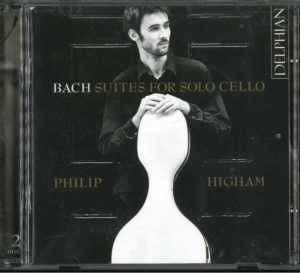
Philip Higham.
Bach Suites for Solo Cello (Delphian DCD34150) Recorded 2014/15
The Cellist.
This appears to be Higham’s 2nd solo recording, following on from a critically acclaimed interpretation of the Britten Suites. The Bach Suites have also had their fair share of praise in the press and online media. (Gramophone and Early Music Review to name but 2 of these). However, some reviewers were a bit more muted this time. Higham cites his primary source as being the Anna Magdalena copy, something not as common these days. He uses his regular 1697 Testore cello for the first 5 Suites, but then changes over to a 2013 5 string cello made by Kai-Thomas Roth for the 6th Suite.
The Recording.
In performance style Higham is clearly leaning to the baroque and uses gut strings throughout. Intriguingly he acknowledges in the informative booklet notes that he was reading off the manuscript for the recording (whilst he would play in concert without the score….). The notes are well worth reading in full.
The Music.
Turning to the performance I find I am a little conflicted in my thoughts. I enjoyed the first 3 Suites very much without quite being sure why. All I can say is they felt a very comfortable listen without if I am honest providing any great insights to the pieces.
There didn’t seem to be any moments of supreme repose, nor conversely, generating a quickening of the pulse. They were pleasant…
The second half.
Turning to disc two of the set the 4th Suite had a nice balance to it with very clean playing and I did particularly enjoy the added bounce he seemed to generate in the Bourrees.
By the 5th Suite I identified something I was becoming less comfortable with. The Allemande felt a bit spiky and there was for sure a tendency to slightly shorten rather than round off notes. The Sarabande was also rather quick for my liking losing its sense of mystery (perhaps just a matter of taste of course). Of further concern was intrusion from Higham’s breathing – a complete no no for me!
The first 5 Suites on the Testore presented a nice warm sound in the resonant acoustic of the church they were recorded in.
The 6th Suite in contrast, whist retaining the clean sound mentioned previously, came across as brighter and a little thin. Again, I didn’t take to the sharply delineated almost clipped notes in the Prelude. Here, it felt like Higham was biting into the strings a bit more. However, I accept that my preference to a smoother flowing presentation is a matter of choice.
The dance movements were lively if not especially quick. Unfortunately, he didn’t for me make enough of the slower Sarabande for my taste. What is usually a stand out moment in the whole work sounded somewhat perfunctory.
Conclusion.
Taking the set overall I found I took to the first 4 Suites more than the last 2 but to be fair they were all well executed, no doubt in line with Higham’s intentions at this juncture of his career. I can see them being a safe choice for many, especially if they lean towards Period performing styles.
Having said that I do feel that David Watkin’s highly praised set meets that brief better, and he is certainly prepared to take more risks than Higham, normally with an impressive payoff. Higham is not ultimately a shortlist choice for me.
Mark.
Philip Higham.
As an addendum to Mark’s full review I thought I would add a few thoughts of my own. Overall, I was more impressed and touched by this interpretation of the Suites. I do agree that possibly the sixth suite loses some coherence and the sound of the five string cello is so different that the flow from earlier suites is interrupted. It would be fascinating if Higham had played the sixth suite on both cellos. I am not aware of any performer releasing a recording of the complete suites doing this.
Poise and Grace.
This niggle aside I thought that this was a performance worthy of greater plaudits. What most impressed was the sense of poise and grace. I was constantly holding an image of period dancers moving gracefully with supreme balance and refinement. Particularly in modern interpretations the dance nature of the movements other than the Preludes is rather obscured. Sometimes playing can be somewhat ponderous but Higham plays with great lightness and agility. Even in the sixth suite I liked the spikiness that Mark refers to of the Prelude and the Allemande was played beautifully.
Conclusion.
I would recommend this to anyone who feels as I do about the need to feel a rhythm and movement in this music, I feel you will not be disappointed!
Charles